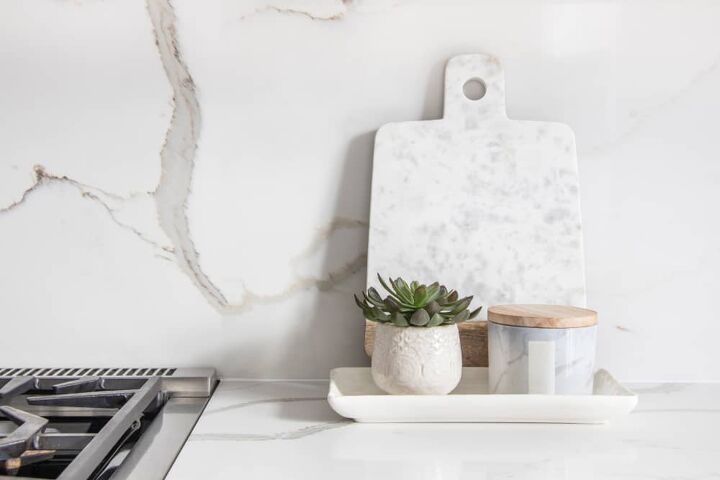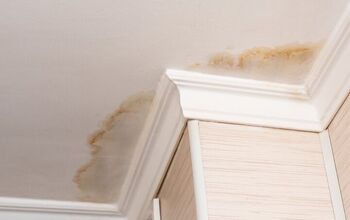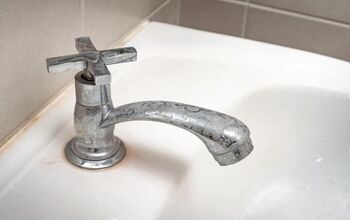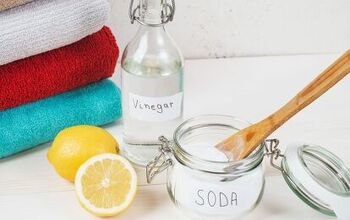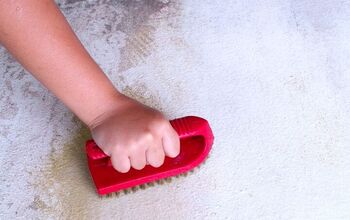How To Remove Water Stains From Marble (Quickly & Easily!)

Marble is a staple element in the interior design of many homes. As a versatile and elegant material, marble can be used in pillars, backsplashes, flooring, countertops, and more. Unfortunately, marble can become stained with water over time.
Whether it is a statement piece or an accent in a room, water stains detract from the value of the marble. Depending on the color of the marble, it can show the defect across a room. So how do you remove water stains from marble?
You can easily remove water stains from marble and affordably with ingredients you likely already have in your own home. Household items such as baking soda, rubbing alcohol, or dish soap are just some many options to remove water stains on your marble. Ingredients such as chalk, vinegar, and cornstarch are other ways many people would not think but do the trick.
Don't want to do it yourself?
Get free, zero-commitment quotes from pro contractors near you.

What is the Real Cause of Water Stains?
Water stains are caused not just by the water but the minerals dissolved into the water, which is left behind when the water evaporates. This process leaves residue on the marble, making it cloudy and reducing its shine. As this residue builds up, it will attract further staining, so it is wise to nip stains in the bud once you spot them.
Marble is a very durable material, hence its popularity for use in countertops and other furniture. However, it is more porous than other materials like granite. This makes it vulnerable to water stains and the damage they cause. Be careful not to confuse etches with watermarks.
The methods listed in this article avoid creating further damage to the marble, such as scratches. However, sometimes these scratches already exist and can be confused with stains. Attempting to clean up stains that are etches will make for a very frustrating process.
Maintenance for Marble Tops
For all the methods listed in this article, it is recommended that distilled water be used rather than tap water. As the minerals often create water stains in the water, you should use distilled to avoid additional damage. Tap water contains fluoride, chlorine, bleach, and other chemicals that not only scratch but corrode the marble.
Always ensure the marble surface is dry when you are done removing stains. Leaving the surface wet will only create future water stains to remove. When utilizing the methods below, avoid acidic or abrasive substances unless they are diluted to avoid scratches or damage to the polish of your marble.
3 Methods for Removing Light Water Stains
These are some methods you can choose to clean the water stains from the marble. Some are widely used, while others some people may not be aware of.
Method 1: Using Baking Soda
Are you looking for an easy way to remove light water stains? Baking soda paste may be the answer. Baking soda paste is suitable for light stains, but note should only be used on polished marble.
To begin, you will need baking soda, water, a brush, and a sponge.
Step 1: Mix the Ingredients. Fill a container with two parts baking soda and one part water, adding more water if necessary. It will turn into a paste consistency needed to clean the marble.
Step 2: Wet the Stain First. Lightly wet the stains with water and apply the baking soda paste.
Step 3: Get the Proper Brush. Choose a non-abrasive tool, such as a soft bristle brush, to scrub the paste into the stain.
Step 4: Commence to Cleaning. Use distilled water and a sponge to remove the paste from the marble surface.
Step 5: Dry the Surface. Dry the marble with a soft cloth.
Method 2: Using Chalk
If you have chalk on hand, you can give it another use. Chalk is an excellent choice for light water stains as it is gentle. The softness of the chalk will not scratch the marble.
It is recommended to use about three sticks of chalk, but you can adjust it based on the task at hand. You will also need cotton balls, water, and a container for the chalk for this method.
Step 1: Crush the Chalk into Fine Pieces. Crush the chalk and transfer it to a container. You can use a mortar and pestle for this. Alternatively, you can place the chalk in a Ziploc bag and crush the chalk using a rolling pin.
Step 2: Put the Chalk Over the Affected Area. Sprinkle the chalk dust on the stains.
Step 3: Clean the Affected Area. Dampen a cotton ball and place it on the stain, rubbing it in a circular motion.
Step 4: Rinse and Dry the Area. Rinse off the surface with water and dry with a soft cloth.
Method 3: Using Cornstarch
Cornstarch is not just a valuable baking ingredient. Like baking soda, this kitchen ingredient can come in handy for removing water stains.
Step 1: Dampen the AreaLightly wet the stains with water.
Step 2: Apply the Cornstarch. Dust the stains with cornstarch.
Step 3: Let the Mixture Sit. Leave the cornstarch on the stain for up to 24 hours.
Step 4: Remove the Dried Mixture. Scrape cornstarch with a tool (ex. a spatula).
Step 5: Clean the Residue. Remove the cornstarch residue with a damp sponge.
Step 6: Rinse and Dry the Area. Rinse the surface and dry with a soft cloth.
Methods for Removing Stubborn Stains
Sometimes there are stains worse than water spots that will not let go. This list of helpful procedures can perfect your task of cleaning.
Method 1: With Baking Soda Poultice
Sometimes water stains also contain soap residue making them more challenging to remove. When this happens, additional removal methods are called. The first of these is a baking soda poultice.
Like the baking soda paste, this method utilizes a mixture of water and baking soda. This method is ideal for stubborn stains because it is left on the stain for an extended period. The residue from the stain transfers to the poultice during this time.
This method requires tape and plastic wrap.
Step 1: Mix the Ingredients. Mix baking soda with cold water in increments of one tablespoon until you reach a paste consistency.
Step 2: Dampen the Area with Water. Lightly wet the stain with water.
Step 3: Apply the Paste. Cover the stain with your paste. The poultice should be at least several millimeters thick.
Step 4: Seal the Paste. Cover the poultice of baking soda paste with plastic wrap. Seal the edges to the marble with tape.
Step 5: Let the Mixture Sit. Leave the mixture on the marble for 8-12 hours or overnight.
Step 6: Remove the Seal. Remove the plastic wrap after this time.
Step 7: Remove the Paste. Use a tool (ex. a spatula) to remove the poultice paste.
Step 8: Clean the Area. Using dish soap and a sponge, clean the marble to remove any baking soda residue.
Step 9: Dry the Marble. Dry the surface with a soft cloth.
Method 2: Using Rubbing Alcohol
Moving away from kitchen ingredients and into the medicine cabinet, rubbing alcohol is effective in removing water stains from marble. Rubbing alcohol is a harsh substance. It is critical to dilute it before using it on your countertop or other marble surfaces.
This method requires water, rubbing alcohol, dish soap, and a spray bottle.
Step 1: Mix the Ingredients. Mix two parts water and one part rubbing alcohol into a spray bottle.
Step 2: Add Soap to the Mixture. Add five drops of dish soap to the mixture.
Step 3: Apply the Mixture to the Stains. Spray the solution on the stains.
Step 4: Wipe Off the Stains. Wipe the stains off the surface using a cloth.
Step 5: Clean Off the Residue. Clean the marble with a damp sponge.
Step 6: Dry the Area. Dry with a soft cloth.
Method 3: Using Vinegar
We use vinegar as a popular ingredient in many store-bought marble cleaners for the last method. Vinegar is an acidic substance at full strength; it can eat away at the marble polish. The vinegar must be diluted before use so that no damage is caused to the marble.
Step 1: Dilute the Vinegar. Mix half and half of white vinegar and distilled water.
Step 2: Add Dish Soap. Add a few drops of dish soap and mix.
Step 3: Apply the Solution. Spray the vinegar solution on the stains.
Step 4: Clean the Marble. After letting the solution soak for a minute, use a sponge to scrub the marble.
Step 5: Remove the Residue. Using distilled water, remove the residue and clean the surface.
Step 6: Dry Everything. Dry the surface with a soft cloth.
Don't want to do it yourself?
Get free, zero-commitment quotes from pro contractors near you.

Prevention
An excellent way to avoid water stains is regularly cleaning your counter and drying the surface right away. Use protective sheets when cooking or drying dishes can prevent water from pooling on the marble surface.
Another preventative step you can take is sealing the marble and works best on countertops. Sealers are store-bought and applied at home with a brush or a spray bottle.

We are a team of passionate homeowners, home improvement pros, and DIY enthusiasts who enjoy sharing home improvement, housekeeping, decorating, and more with other homeowners! Whether you're looking for a step-by-step guide on fixing an appliance or the cost of installing a fence, we've here to help.
More by Upgraded Home Team



